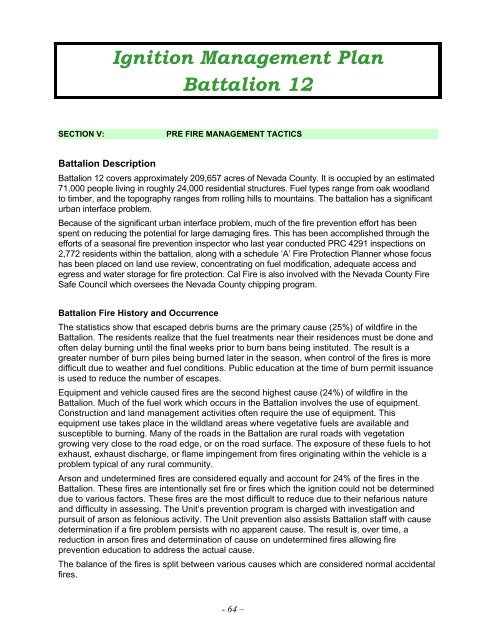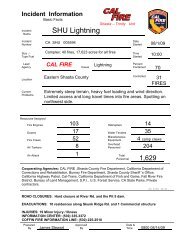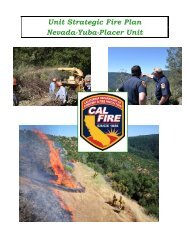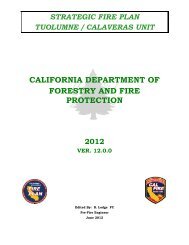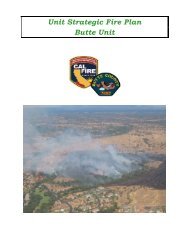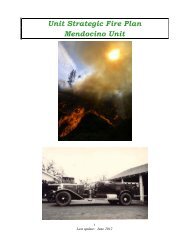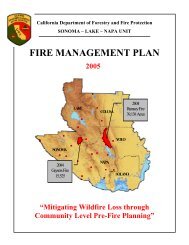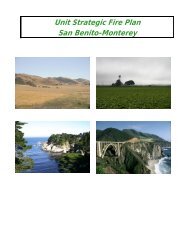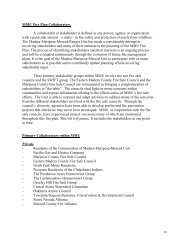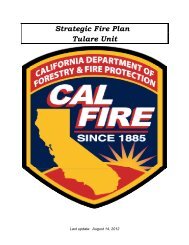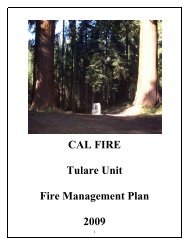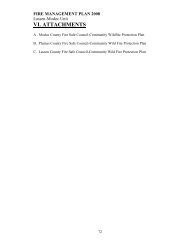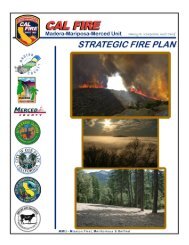Nevada-Yuba-Placer Strategic Fire Plan 2011 - Board of Forestry ...
Nevada-Yuba-Placer Strategic Fire Plan 2011 - Board of Forestry ...
Nevada-Yuba-Placer Strategic Fire Plan 2011 - Board of Forestry ...
You also want an ePaper? Increase the reach of your titles
YUMPU automatically turns print PDFs into web optimized ePapers that Google loves.
Ignition Management <strong>Plan</strong><br />
Battalion 12<br />
SECTION V: PRE FIRE MANAGEMENT TACTICS<br />
Battalion Description<br />
Battalion 12 covers approximately 209,657 acres <strong>of</strong> <strong>Nevada</strong> County. It is occupied by an estimated<br />
71,000 people living in roughly 24,000 residential structures. Fuel types range from oak woodland<br />
to timber, and the topography ranges from rolling hills to mountains. The battalion has a significant<br />
urban interface problem.<br />
Because <strong>of</strong> the significant urban interface problem, much <strong>of</strong> the fire prevention effort has been<br />
spent on reducing the potential for large damaging fires. This has been accomplished through the<br />
efforts <strong>of</strong> a seasonal fire prevention inspector who last year conducted PRC 4291 inspections on<br />
2,772 residents within the battalion, along with a schedule ‘A’ <strong>Fire</strong> Protection <strong>Plan</strong>ner whose focus<br />
has been placed on land use review, concentrating on fuel modification, adequate access and<br />
egress and water storage for fire protection. Cal <strong>Fire</strong> is also involved with the <strong>Nevada</strong> County <strong>Fire</strong><br />
Safe Council which oversees the <strong>Nevada</strong> County chipping program.<br />
Battalion <strong>Fire</strong> History and Occurrence<br />
The statistics show that escaped debris burns are the primary cause (25%) <strong>of</strong> wildfire in the<br />
Battalion. The residents realize that the fuel treatments near their residences must be done and<br />
<strong>of</strong>ten delay burning until the final weeks prior to burn bans being instituted. The result is a<br />
greater number <strong>of</strong> burn piles being burned later in the season, when control <strong>of</strong> the fires is more<br />
difficult due to weather and fuel conditions. Public education at the time <strong>of</strong> burn permit issuance<br />
is used to reduce the number <strong>of</strong> escapes.<br />
Equipment and vehicle caused fires are the second highest cause (24%) <strong>of</strong> wildfire in the<br />
Battalion. Much <strong>of</strong> the fuel work which occurs in the Battalion involves the use <strong>of</strong> equipment.<br />
Construction and land management activities <strong>of</strong>ten require the use <strong>of</strong> equipment. This<br />
equipment use takes place in the wildland areas where vegetative fuels are available and<br />
susceptible to burning. Many <strong>of</strong> the roads in the Battalion are rural roads with vegetation<br />
growing very close to the road edge, or on the road surface. The exposure <strong>of</strong> these fuels to hot<br />
exhaust, exhaust discharge, or flame impingement from fires originating within the vehicle is a<br />
problem typical <strong>of</strong> any rural community.<br />
Arson and undetermined fires are considered equally and account for 24% <strong>of</strong> the fires in the<br />
Battalion. These fires are intentionally set fire or fires which the ignition could not be determined<br />
due to various factors. These fires are the most difficult to reduce due to their nefarious nature<br />
and difficulty in assessing. The Unit’s prevention program is charged with investigation and<br />
pursuit <strong>of</strong> arson as felonious activity. The Unit prevention also assists Battalion staff with cause<br />
determination if a fire problem persists with no apparent cause. The result is, over time, a<br />
reduction in arson fires and determination <strong>of</strong> cause on undetermined fires allowing fire<br />
prevention education to address the actual cause.<br />
The balance <strong>of</strong> the fires is split between various causes which are considered normal accidental<br />
fires.<br />
- 64 –


